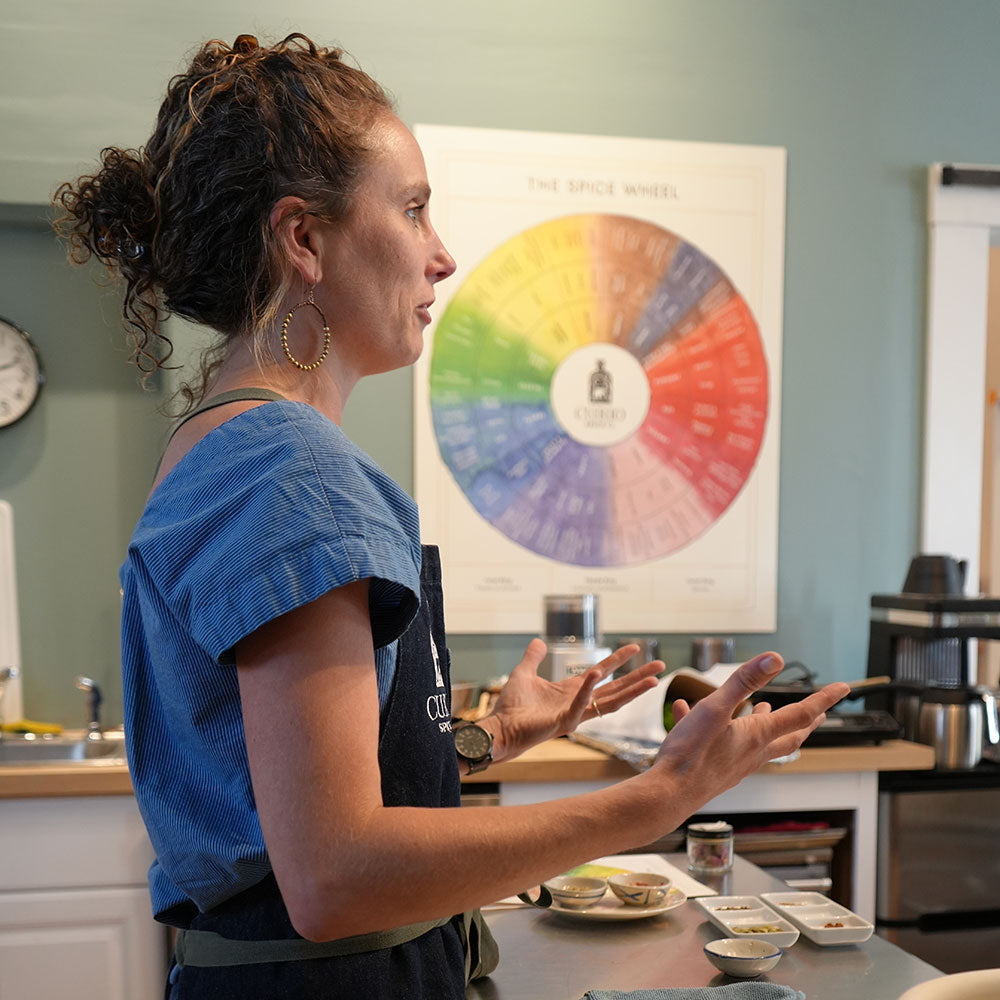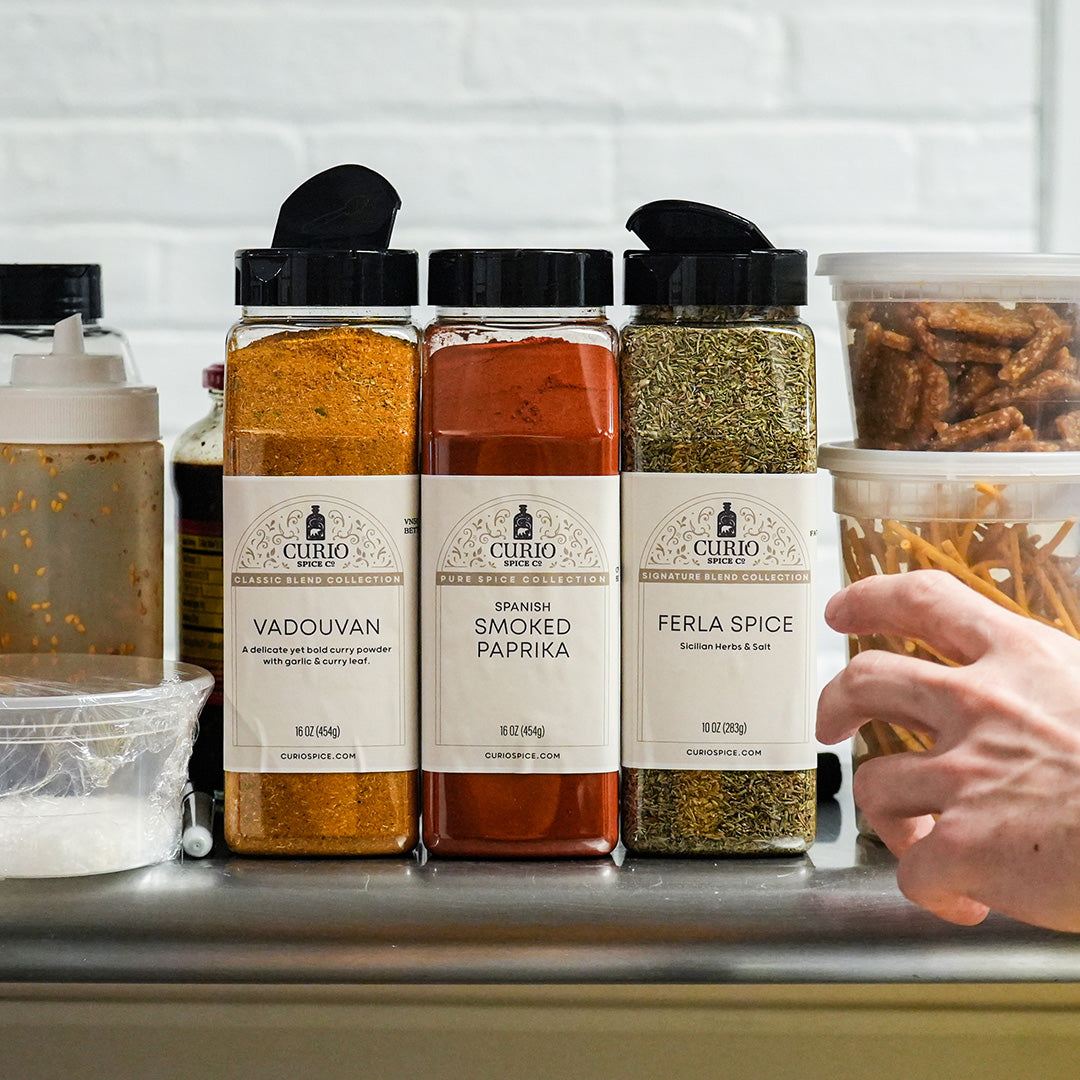The Sweet Life of Sour Spices
words and pictures by John Kilfoyle
Sourness is something we often try to avoid. The sourness of spoiled milk, rancid butter, and flattened beer are all indications that these things have been out for too long, left to ferment and turn acrid. Sourness is one of the 5 fundamental flavors–along with sweetness, saltiness, bitterness, and umami– and the development of our sour and bitter taste buds is thought to be an evolutionary response to detecting food that has gone bad and could possibly poison us. If sourness means danger then why are we sometimes drawn to sour foods? Yogurt, vinegar, citrus, wine, beer, and of course, sour candies are staple foods around the world. But what about spices? The most common spices are flavors that intend to be harmonious with umami and sweet–dinner and dessert–with saltiness as an added bonus and bitter and sour totally forgotten. But sourness can add something special to a dish, a danger that tests the limits of what is acceptable as “good food.” Acidity adds brightness and pizazz to a more basic dish and can be more cooling and refreshing than anything sweet. Here are some ways to add sourness to your foods.
Meat
Despite the unappetizing concept of sour meat, which brings to mind rancidness and rottenness, meat dishes with a sour flavor profile are actually commonplace throughout the world. Sauerbraten, which is red meat marinated in vinegar or wine and spices, is the national dish of Germany and is often eaten with its sour-cousin, the vinegar inflected Rotkohl. The vinegar gives the dish a great tang and mouth watering acidity that contrasts with the rich and heavy red meat, making a dynamic and appetizing meal. While the following recipe isn’t Sauerbraten, it captures the same idea - rich and succulent chicken paired with bright, sour spices.
 |
Spicy Sumac Whole Roast Chicken 1 4.5 pound chicken |
Spice Blend: 1 1/2 tsp sumac |
1 1/2 tsp salt 1/4 tsp black pepper 1/2 tsp granulated garlic 1/4 tsp red pepper flake 1 tsp Herbes de Romance 1/2 tsp onion powder |
First mix the spices together in a small bowl. I really wanted the fruity and tart sumac to shine in this dish so that’s why it has pride of place. Sumac’s sour siblings black lime powder and amchoor (who you will see again soon) needed to join it. Keeping with the Mediterranean and Middle Eastern themes established by the Lebanese sumac, Persian black lime, and Indian amchoor, I also added the Indian turmeric, Sicilian Ferla Spice, French Fleur Spice, and Greek Kozani Spice. The salt, pepper, red pepper flake, and aromatic allium powders rounded out the palette of the blend.
Place the whole chicken in your baking dish then slather it in olive oil. Take pinches of the spice blend and rub it on the chicken, making sure to get the underside, the inside, and especially under the skin. Then cut the red onion into roughly six parts and put some inside the chicken to flavor it and the rest beside the chicken to roast in its juices (a white onion would work fine as well). Crush the garlic and rub it on the chicken before putting it in. Who doesn’t love garlic? Next, quarter the lemon and squeeze it on the chicken, then put the lemon inside the chicken. Although sumac and lemon taste different, they can function in similar ways flavorwise: they both share a fruity, tart flavor that enhances the dish. Putting thyme into the cavity adds a fresh herbaceous flavor. Other fresh herbs like rosemary, tarragon, and oregano would also work here.
Bake the chicken at 400 degrees for roughly an hour. My oven runs cool, so I would start checking after 45 minutes. I played scrabble in the meantime. If the chicken looks nice and crispy on the outside and the juices from the deepest part of the thigh run clear (internal temp of at least 165), take it out and let the chicken rest for 10 minutes. Carve it up and dig in. The cooked chicken turned a pleasant golden color thanks to the turmeric and it had this breezy tart flavor complicated by the deep fattiness of the chicken and a well earned sweetness from the onion. It was lip-smackingly good and my family rightfully placed it up there with our best roast chickens. While writing this my mouth is watering. Sourness need not be sequestered to the realm of brightly packaged candies!
Sour Patch Fruits
Fruits are no stranger to sour. Many of the most popular sour ingredients are fruits: lemons, limes, grapefruits, tart cherries, cranberries, tamarind… The list goes on and on. So naturally, it’s no surprise that fruit and sourness can live together in harmony. When it comes to spices, many fruits can still stand strong in the face of other flavors: watermelon pairs well with salt and fresh herbs, apples with cinnamon, and sweet mangoes can dance with fiery chile-citrus salts. Here is a recipe that plays up fruits’ strongest partnerships: spice and sourness.

|
Not Your Average Fruit Salad 2 cups ripe mango, cut into bite size pieces |
While it may seem conventional to pair sour with sweet in the fruit bowl, this fruit salad is not your average brunch dish. This fruit salad uses spices instead of additives to get that tangy, sour flavor. First combine your chopped fruit in a medium serving bowl. Then mix in the amchoor, black lime powder, and chopped mint into the bowl and gently toss until the spices are evenly distributed.
I was curious about black lime the first time I tried it. The powder is jet black and has the appearance and scent of Lipton Ice Tea Powder (my friends who were sampling the black lime powder agreed with me) but despite the odd comparison it has a tart, funky, and, well, limey taste with more complexity than their fresh counterparts. Black limes are typical in Middle Eastern cuisine and made by blanching fresh limes in a salt bath then curing them until they turn black and hard. While often used in braised meat recipes, black lime adds a moody, citrus flavor to this fruit salad.
What makes this fruit salad pop is the amchoor powder. This spice is made from unripe mangoes that have been dried and crushed into a powder, yielding a fruity, sweet, and definitely sour taste that puts citric acid to shame. There is a certain earthiness to it with its silver-bark color that makes any dish more comforting. It pairs so well with these fruits (especially its ripe sister, the mango) that you could simply make a meal out of amchoor sprinkled on slices of summer fruit.
Sipping Sour
If there is any realm where sourness is most familiar, it is in the realm of drinks. Wine, beer, tea, coffee, kombucha, and fruit and vegetable juices all have sour (or sometimes bitter) tastes. These can cut the sweetness of your dessert or offer relief when you’re eating a rich and heavy meal. Cool drinks can help break the heat on these summer days. Here is a cool, tart drink to be enjoyed after a long walk, or with a lovely roast chicken.
 |
Roselle-Lemongrass Agua Fresca 1 cup dried roselle blossoms |
First, in a medium size saucepan, pour 6 cups of water and bring to a boil. Add the sugar and stir slowly, making sure it doesn’t burn. Once the sugar is dissolved, turn off the heat and add the dried roselle and lemongrass, using a spoon to push the spices down so they're submerged. Let the tea steep for about ten minutes then remove the herbs. Let the tea cool to room temperature while you prepare the rest of the drink. Roselle is a type of hibiscus, so the flavor is similar: tart, almost bitter, savory, and fruity. The lemongrass is a personal favorite of mine, imparting a gentle, grassy and citrusy flavor.
Quarter the lemons, oranges, and limes, squeezing their juices into the serving pitcher then throwing the quarters in as well. Add the two cups of pineapple pieces and the sprigs of washed mint. Then pour in the tea, seltzer, and ice and stir until all the flavors are combined. The sweetness of the fruit and sugar, the chill of the ice and the fizz of the seltzer are complicated by the roselle. The roselle’s sourness pushes against your tastebuds, the deep ruby red warning you to stop, but as soon as you put the drink down you are immediately back for more, wanting to taste again the fruit, the cold, the tart, the tang.








Makes me want to start cooking!
Leave a comment